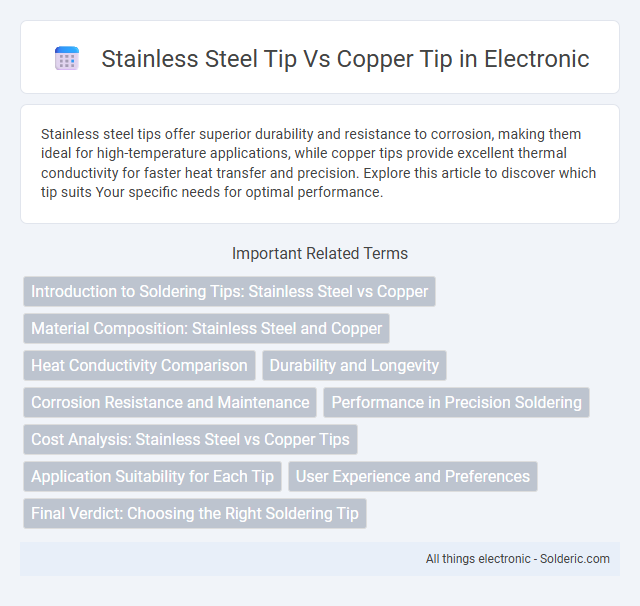Stainless steel tips offer superior durability and resistance to corrosion, making them ideal for high-temperature applications, while copper tips provide excellent thermal conductivity for faster heat transfer and precision. Explore this article to discover which tip suits Your specific needs for optimal performance.
Comparison Table
| Feature | Stainless Steel Tip | Copper Tip |
|---|---|---|
| Thermal Conductivity | Low to Moderate (16 W/m*K) | High (401 W/m*K) |
| Durability | High resistance to corrosion and wear | Moderate; prone to oxidation |
| Cost | Higher | Lower |
| Common Uses | Applications needing corrosion resistance and durability | Applications requiring efficient heat transfer |
| Maintenance | Low | Requires regular cleaning to prevent oxidation |
Introduction to Soldering Tips: Stainless Steel vs Copper
Soldering tips play a critical role in heat transfer efficiency and durability, with stainless steel and copper being two common materials. Copper tips offer exceptional thermal conductivity, allowing for faster heating and better solder flow, while stainless steel tips provide superior corrosion resistance and longer-lasting performance under harsh conditions. Selecting between stainless steel and copper depends on balancing thermal efficiency with wear resistance for specific soldering applications.
Material Composition: Stainless Steel and Copper
Stainless steel tips are composed primarily of iron, carbon, and chromium, which provides high resistance to corrosion and wear, making them durable in harsh conditions. Copper tips feature a high thermal conductivity due to their pure copper content, allowing for faster heat transfer and precise temperature control, essential for applications like soldering. Your choice between stainless steel and copper tips depends on whether you prioritize longevity and corrosion resistance or thermal efficiency and heat responsiveness.
Heat Conductivity Comparison
Stainless steel tips have lower thermal conductivity (around 16 W/m*K) compared to copper tips, which excel with a high conductivity of approximately 400 W/m*K, enabling faster heat transfer and more efficient heat distribution. This difference impacts soldering precision and temperature recovery speed, with copper tips maintaining consistent heat better under continuous use. Choosing your tip material affects performance, where copper is ideal for rapid heating tasks and stainless steel offers better durability but slower heat response.
Durability and Longevity
Stainless steel tips offer superior durability and resistance to wear, corrosion, and high temperatures compared to copper tips, making them ideal for prolonged use in soldering applications. Copper tips, although excellent for thermal conductivity, tend to degrade faster due to oxidation and tip erosion, reducing their longevity. The inherent hardness of stainless steel prolongs tip life, minimizing frequent replacements and maintaining consistent soldering performance over time.
Corrosion Resistance and Maintenance
Stainless steel tips offer superior corrosion resistance compared to copper tips due to their chromium content, which forms a protective oxide layer preventing rust and degradation. Copper tips, while excellent for thermal conductivity, require regular maintenance such as cleaning and oxidation prevention to avoid corrosion and maintain performance. Your choice should consider the environment and maintenance capabilities, with stainless steel tips providing longer-term durability and less frequent upkeep.
Performance in Precision Soldering
Stainless steel tips provide superior durability and resistance to corrosion, maintaining consistent heat transfer during precision soldering tasks. Copper tips offer excellent thermal conductivity, ensuring rapid heat-up times and precise temperature control, which is crucial for delicate electronic components. Your choice depends on whether you prioritize longevity or initial thermal performance in intricate soldering work.
Cost Analysis: Stainless Steel vs Copper Tips
Stainless steel tips typically cost more upfront due to higher material and manufacturing expenses but offer longer durability and resistance to corrosion, reducing replacement frequency. Copper tips, while cheaper initially, wear out faster and conduct heat more effectively, which can lead to quicker degradation under high temperatures. Evaluating total cost of ownership, stainless steel tips may provide better long-term value despite the higher initial investment.
Application Suitability for Each Tip
Stainless steel tips are ideal for high-temperature soldering applications requiring durability and resistance to corrosion, making them suitable for heavy-duty electronic repairs and industrial uses. Copper tips excel in heat conductivity, providing quick and even heating, which is perfect for precision work on sensitive circuit boards and intricate solder joints. Your choice depends on whether you prioritize long-lasting endurance with stainless steel or superior thermal performance with copper.
User Experience and Preferences
Stainless steel tips offer greater durability and corrosion resistance, making them ideal for users who prioritize longevity and consistent performance in harsh environments. Copper tips provide superior thermal conductivity, enhancing heat transfer efficiency and appealing to those who value precise temperature control and faster heating times. Your choice depends on whether you prefer robustness and maintenance ease or enhanced thermal responsiveness for your specific applications.
Final Verdict: Choosing the Right Soldering Tip
Stainless steel tips offer durability and corrosion resistance, ideal for heavy-duty soldering tasks, while copper tips provide superior thermal conductivity for precise heat transfer in delicate electronics work. Your choice depends on the specific demands of your project, balancing durability against performance sensitivity. For long-term use and rugged applications, stainless steel tips are preferable, whereas copper tips excel in accuracy and efficient heat distribution.
stainless steel tip vs copper tip Infographic

 solderic.com
solderic.com